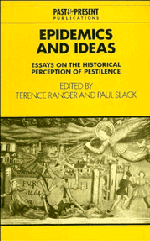Book contents
- Frontmatter
- Contents
- Contributors
- Preface
- 1 Introduction
- 2 Epidemic, ideas and classical Athenian society
- 3 Disease, dragons and saints: the management of epidemics in the Dark Ages
- 4 Epidemic disease in formal and popular thought in early Islamic Society
- 5 Plague and perceptions of the poor in early modern Italy
- 6 Dearth, dirt and fever epidemics: rewriting the history of British ‘public health’, 1780–1850
- 7 Epidemics and revolutions: cholera in nineteenth-century Europe
- 8 Hawaiian depopulation as a model for the Amerindian experience
- 9 Plague panic and epidemic politics in India, 1896–1914
- 10 Plagues of beasts and men; prophetic responses to epidemic in eastern and southern Africa
- 11 Syphilis in colonial East and Central Africa: the social construction of an epidemic
- 12 The early years of AIDS in the United Kingdom 1981–6: historical perspectives
- Index
- Past and Present Publications
10 - Plagues of beasts and men; prophetic responses to epidemic in eastern and southern Africa
Published online by Cambridge University Press: 05 August 2011
- Frontmatter
- Contents
- Contributors
- Preface
- 1 Introduction
- 2 Epidemic, ideas and classical Athenian society
- 3 Disease, dragons and saints: the management of epidemics in the Dark Ages
- 4 Epidemic disease in formal and popular thought in early Islamic Society
- 5 Plague and perceptions of the poor in early modern Italy
- 6 Dearth, dirt and fever epidemics: rewriting the history of British ‘public health’, 1780–1850
- 7 Epidemics and revolutions: cholera in nineteenth-century Europe
- 8 Hawaiian depopulation as a model for the Amerindian experience
- 9 Plague panic and epidemic politics in India, 1896–1914
- 10 Plagues of beasts and men; prophetic responses to epidemic in eastern and southern Africa
- 11 Syphilis in colonial East and Central Africa: the social construction of an epidemic
- 12 The early years of AIDS in the United Kingdom 1981–6: historical perspectives
- Index
- Past and Present Publications
Summary
INTRODUCTION
In his chapter in this book and in his splendid monographs Alfred Crosby describes how epidemic and endemic diseases, introduced by Europeans, wiped out whole aboriginal populations and decimated and demoralised others. The victims lost confidence in their own culture and in their capacity to respond. This chapter also describes a crisis of human and animal epidemic, this time in eastern and southern Africa during the late nineteenth and early twentieth centuries when diseases from Europe and from imperial India ravaged Africa. One African people – the so-called ‘Hottentots’ of Cape Colony – were destroyed as a culture by disease, expropriation and settler violence. But in general my story is different from Crosby's. It deals with societies which biologically were not undermined and which in the end survived the crisis of disease to commence vigorous population growth. Above all, it deals with societies which had not lost cultural self-confidence and which retained the capacity to respond intellectually. It is with these intellectual – and particularly religious – responses to epidemic that this chapter is concerned.
The chapter deals with two human diseases – smallpox and influenza; and two cattle diseases – lungsickness and rinderpest. Its argument is that study of response to these diseases allows us to understand something of the dynamics of all three of the major ideological systems of eastern and southern Africa. In the period under study such ideological systems were inevitably religious.
- Type
- Chapter
- Information
- Epidemics and IdeasEssays on the Historical Perception of Pestilence, pp. 241 - 268Publisher: Cambridge University PressPrint publication year: 1992
- 22
- Cited by



